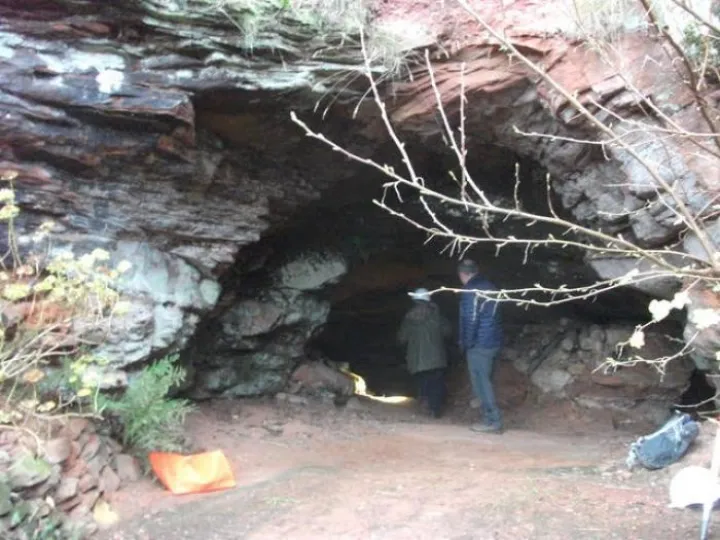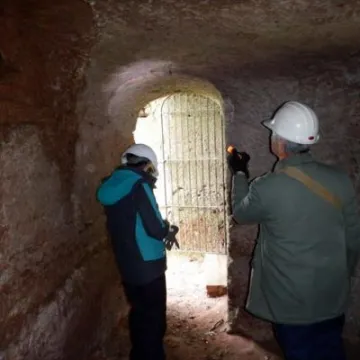Bear Caves on The Sandstone Ridge
Caves associated with the keeping of bears have been visited at two sites on the Ridge: at Bear Hole on The Rock, Helsby, and at Broxton Old Hall, where a cave attached to a picturesque stone 'parlour' is known locally as The Bear Cave. The thought of bears in the woods and bears in caves is often used to frighten but also somehow to delight us. Shakespeare recognised this terror in A Midsummer Night's Dream (Vi) when thinking about the power of the imagination: 'Or in the night, imagining some fear ... How easy is a bush supposed a bear!' and it is easy to suppose that local traditions of bears in caves are simply the imaginative creation of children or their parents trying to frighten them.
Of course, bears did once represent a real threat until they became extinct in the early Middle Ages, and there is plenty of evidence that tamed bears have been kept in Britain in the more recent past. Bears have been kept as a source of street entertainment, for baiting by dogs and as exhibits in private menageries. It is worth considering, therefore, whether these Cheshire cave names might have any foundation in fact.
Often associated with travelling shows and individual entertainers, there were still dancing bears imported to Britain in the late nineteenth century. In 1887, the Manchester Evening News reported on one such having escaped from a group of Germans performing in Tarvin(1). The practice, however, was outlawed in 1911(2). Unfortunately, displaying dancing bears was by no means the cruellest exploitation of the animals. In the sixteenth and seventeenth centuries they were kept for the express purpose of baiting. In 1819, the historian George Ormerod commented on 'The predilection of the inhabitants of Congleton in the seventeenth century for the elegant divertisement (sic) of bear-baiting' and recorded between 1589 and 1622, among several references to payments for players and cockfighting, payments to 'Bearwards'. For example, in 1613:
Gave to Mr Hardern to fetch Shelmadine and his Bears 1s.3d. when the Great Cockfighting was at Whitsuntide, and he refused to come, and Brack the Bearward and his bears came, gave him 6s.8d....Fetching the Bears at the Wakes, 3s.6d. ditto two more Bears 1s. Bearward 15s. (3)
It may be deduced from these references that a town in Cheshire might be only too eager to support the practice of keeping bears for this kind of entertainment.
The Bear Hole at Helsby is today in a private garden on The Rock but in the eighteenth century this land was owned by the township. Local folk-law holds that a bear used for bear-baiting in a field opposite the Robin Hood Inn was kept in this cave. No firm evidence has been found to support this claim but the story was well established in the nineteenth century when an article in the Chester Observer, 1 February 1896 about the Helsby Water Scheme referred to The Rock as 'Bear's Hole Lane'.
The old pub moved to a new site following the building of the turnpike in about 1790 and bear-baiting was abolished nationally under the Cruelty to Animals Act in 1835. That is no guarantee of when bear-baiting might have ceased in Helsby but it would suggest that the keeping of a bear or bears in that cave is unlikely to have continued beyond the end of the eighteenth century. There is no longer any physical evidence of a cage but the cave is certainly spacious enough to have been used in that way. There is, however, evidence that the cave was partly excavated by sand merchants in the nineteenth century so signs of bear-keeping would have been erased.
- Photo 1 (top centre) – Entrance to the Bear Hole, Helsby
At Broxton the story may have been rather different. Here the bear is associated with a large and ancient house. In the grounds of Broxton Old Hall there is a terrace path, probably designed as an ornamental walk, with impressive views to the West over the Dee valley. Cut into the sandstone cliff along the path are a series of ornamental features, seats and viewpoints that pre-date the modern garden. Best preserved of these features is a "Stone Parlour"(4) and opening into this is a partly natural cave that at one time had a strong door. It is known locally as The Bear Cave.
The Hall was originally built in 1595. In 1873, in the ownership of the Egerton family, it was refurbished by the prominent Cheshire architect, John Douglas. However, it is unclear when the garden features were originally created.
- Photo 2 (lower left) – The Stone Parlour, Broxton; the Bear Cave opening to the right of the doorway
The Parks and Gardens UK database records a 'grotto' as having been created in 1595 but other features are ascribed to the 1873 refurbishment(5). It may be that Douglas 'improved' the grotto, patching its walls with stone blocks and inserting the impressive window but, given that the Cruelty to Animals Act had been passed in 1835, it is unlikely that any features designed by Douglas were intended to accommodate a bear. Indeed, the assemblage of features suggests that they may have been part of an earlier 'picturesque' garden design of a kind that was popular in the eighteenth century.
- Photo 3 (lower right) – Interior of The Bear Cave
The contrast between the beautifully chiselled ceiling and walls of the spacious parlour with its stone-flagged floor and the cramped, dirt-floored cave certainly leads to speculation about the different ages and uses of the two spaces. It seems most likely that the grotto/parlour, before or after any refurbishment, was used for entertainment. It had a splendid view of the countryside before the present woodland was planted and ledges on the outside may have been used for candles or oil lights after a sunset had been enjoyed.
But what would the little cave have contained? Its location on private land is very unlike that of the cave in Helsby which had been public and near an inn. An association with bear-baiting at Broxton seems less probable. It seems more likely that, if an animal were caged there, it would have been as a curiosity in the tradition of eighteenth-century 'menageries' – the keeping of wild animals in private parks before the advent of zoological gardens. The combination of a decorative walk and parlour, designed for a relaxed perambulation and admiration of the view, with a grim cage containing a fearsome animal may seem unpleasant today but the thrill inspired by the meeting of polite civilised society with wild nature may well have appealed to the 'gothic' tastes of eighteenth-century pleasure-seekers.
There is no indication that this cave has been extended by sand-extractors and so it's dirt floor may still reveal further clues to its purpose. Documentary research into the life of the eighteenth-century residents of the Hall may also add to our understanding of this curious feature.
The Trust would welcome information from anyone who has further knowledge of records of bears in Cheshire.
Peter Winn
With thanks to: Susan Lorimer and Gary Byrne, Helsby, and Sir Malcolm Walker, Broxton; Terri Hull, Tattenhall
Footnotes:
- (1)Manchester Evening News, p2 27 January 1887
- (2)During the Middle Ages dancing bears were a common and popular form of street entertainment throughout Europe and Asia. By the fifteenth century the practice was far less common in Western Europe, although there were still dancing bears in Britain in the late nineteenth century (the practice was outlawed in 1911). Closely linked with travelling shows and individual entertainers it seems that the majority of dancing bear trainers were Romany people from Eastern Europe and Asia. Dancing bears remained a common sight in Eastern Europe and many parts of Asia well into the late twentieth century CLICK HERE.
- (3)Ormerod, George The History of County Palatine of Chester , 1819, Vol II pp 660-665. Ormerod also records that in 1622 'About this time arose the saying of Congleton selling the Word of God to buy a Bear. Thus: there being a new Bible wanted, for the use of the Chapel, and as they were not able at that time to purchase one, they had laid some money by, for the purpose. In the meantime the Town Bear died, and the said money was given to the Bearward to buy another; and the Minister was obliged to make a further shift, and use the old (bible) a little longer...'
- (4)CLICK HERE
- (5)CLICK HERE

Sandstone Ridge Trust
Registered Company No. 7673603
Registered Charity No. 1144470
info@sandstoneridge.org.uk



